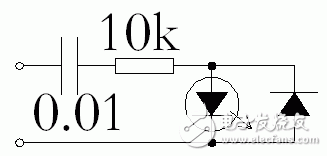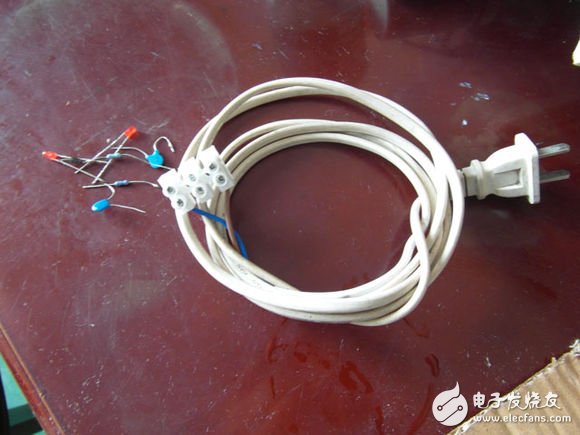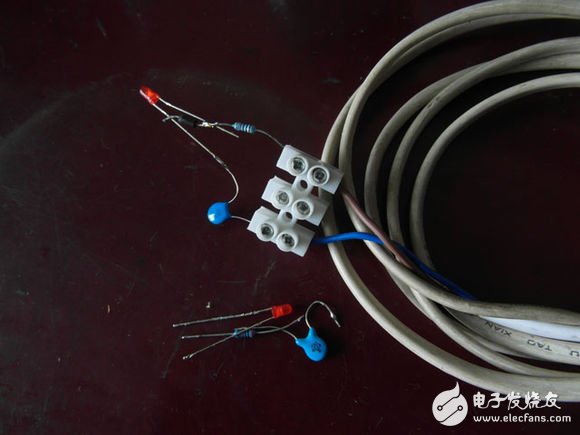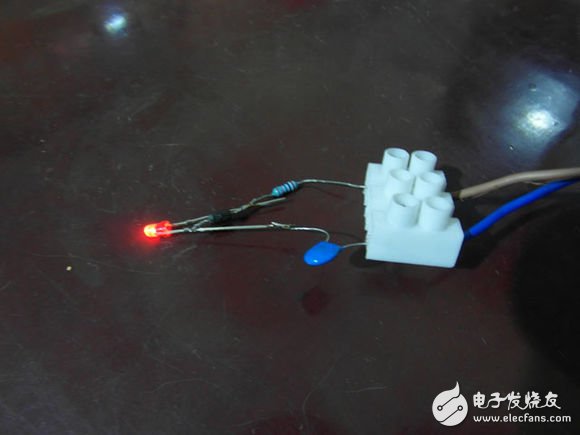When discussing LED indicators a few days ago, some people mentioned the use of capacitor current limiting. I think this is a good way to reduce losses, but the power of a single indicator itself is small, and the total amount of savings is limited.
Generally used for the indicator light on the power strip or some electrical appliances, most of them are directly connected in series with a red LED lamp bead with 1/4w 220k resistor. Such an indicator light consumes about 0.2w, which is very small, but if it is It has been lighting up for a long time, and it consumes about 1.75 degrees a year. If all the LED indicators in the country are counted, it is still quite impressive. In this kind of circuit, the real power-consuming big head is on the resistor, and the power consumption of the lamp bead is very small. If the capacitor is used to reduce the current limit, the loss can be greatly reduced. However, capacitor current limiting has a disadvantage, that is, at the moment of power-on, if the alternating current is not in the state of voltage 0, there will be a large inrush current, so it is necessary to connect an appropriate resistor in series to prevent the moment of power-on. High current impact. In addition, many times I saw this LED indicator is damaged. The reason for the analysis is that the LED is connected with only one resistor. In the negative half of the AC, there will be a high reverse voltage to break down the LED. The LED is a kind of diode, once. Breakdown (that is, reaching the reverse breakdown voltage, but the current is small) will not be damaged, and the second breakdown (large current, serious internal heat, resulting in damage to the semiconductor lattice) will be damaged, in order to avoid reverse voltage damage to the LED. A diode should be added for protection.
After analysis, roughly determine the energy-saving indicator circuit is as follows

In order to carry out the test, a high-voltage ceramic capacitor with a withstand voltage of 1kv is prepared for each of 0.01μ and 4700p (though these capacitors are cheap, the measured capacitance is only about half of the nominal capacity), one for each of the 1/4w 10k and 20k resistors. , 3mm red LED lamp beads, one rectifier diode 1N4007, one wire with plug, one terminal block



First press the 0.01μ capacitor, 20k resistor, diode and LED together, plug it into the terminal block and test the light. Compared with the indicator light on the power strip (220k resistor string 1N4007 and 3mm red LED), the brightness is slightly smaller, but The indicator light is enough to use the 4700p capacitor, and the brightness is smaller.

The next step is the impact test. The plug is continuously plugged and unplugged no less than 100 times. After stringing 20k resistors, in theory the most extreme state (the negative peak of the alternating current is unplugged, the capacitor is reversely charged to the maximum, and the positive peak is inserted to make the resistor And the LED with double peak voltage) pulse current 31mA, there should be no problem. The test passed.
Then test the LED pulse bead's large pulse current test, that is, remove the 20k resistor. If the LED can withstand, the circuit loss will be smaller. Continuously inserted and removed 100 times, and found that the brightness is getting smaller and smaller, and finally only plugged in and flashed instantly. The lamp bead was taken down and measured with a multimeter. It was found that the battery had been seriously leaked and the LED was scrapped. The test seems to be that the impact of a large current causes partial internal damage to the LED, rather than a one-time complete damage.
What is the impact current of the LED? Check it online. The maximum pulse current of the 3mm red LED is 75mA. If a 10k resistor is used, even if the voltage rises to 250v, the maximum peak current is 70mA in extreme conditions. Using a 10k resistor should be sufficient.
Changed another LED lamp bead, the resistance was changed to 10k, and the plug was continuously inserted and removed more than 100 times. The brightness could not be changed. The LED was removed and measured with a multimeter, and almost no leakage was detected, which was exactly the same as before the test. In other words, the string 10k resistor fully meets the requirements.
Circuit calculation analysis:When the capacitance of 0.01μ is at 50Hz, the capacitive reactance Rc=1/(2πfC)=1/(6.28*50*0.01*10^-6)=318.5k, there is such a large capacitive reactance, and the influence of 10k or 20k resistance on current Very small, negligible, so the AC current is 220/318.5k≈0.69mA, which is the effective current calculated by sine wave AC, LED and diode divide this current, LED voltage is about 1.8v, diode voltage is about 0.7v, average voltage About 1.3v, power consumption 1.3v*0.69mA≈0.9mw, the power on the resistor is (0.69mA)^2*10kΩ≈4.8mw, a total power consumption is 5.7mw, which is 0.0057w, only the original indicator circuit 1 /35, it takes about 20 years to use electricity for 1 year, and the brightness is not obvious compared with the series 220k resistance. The brightness is enough. The actual capacity of this capacitor is nearly half, and the brightness is not much smaller. If the capacitance is less than half, the current is reduced by half, the power consumed by the resistor drops to 1/4 of the original, about 1.2mw, and the power consumption of the LED and diode drops by half, about 0.45mw, and the total power consumption is about 1.65mw. Power consumption is 1 degree.
In terms of material cost, my online shopping capacitors are only 0.8 yuan, 0.04 yuan each, and the online price of diodes is about 0.04 yuan. The bulk purchase will be cheaper, and the material cost will increase by less than 0.1 yuan, not only every year (not In case of intermittent use, the power consumption is about 1.7 degrees, and the LED has diode protection, so there is no need to worry about damage.
Glass Aquariums,Aquarium Fish Tank,Glass Turtle Tank,Glass Fish Tank
Sensen Group Co., Ltd.  , https://www.sunsunaquariums.com